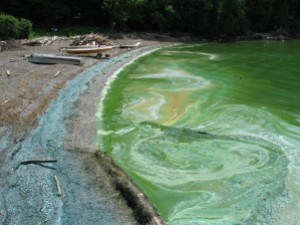Filming A Farming Future For Vermont
April 30, 2014CLIMATE CHANGE: The Bigger Picture by Charles Eisenstein
May 6, 2014Getting Real About Vermont’s Farm Problem by James Maroney
My position on pollution in Lake Champlain is that the state, in a misguided effort to save farming and protect water, an effort spanning fifty years and hundreds of millions of taxpayer dollars, has actually abetted conventional agriculture’s most destructive practices. Worse, this was the political objective.
Modern farming was invented after WWII to raise farm yields and lower costs, which it did by substituting cheap but toxic chemicals for the age-old and time consuming practices of mechanical weed control, crop rotation for soil fertility, both of which required expensive hired labor. Consumers were told that farmers would apply these chemicals in minute concentrations and that residues would dissipate harmlessly. The paradigm worked as advertised: farm yields soon tripled which reduced the average American family’s cost for food from 27% of wages in 1940 to about 9% today, a three-fold savings.
But the paradigm so over produced its markets, that it drove farm prices down below cost, which accelerated farm attrition in marginal states like Vermont and, broadly speaking, effected a massive transfer of wealth out of rural into urban society. Because the paradigm appeared to work, individual farmers each had to adopt the paradigm to raise production and cut costs or die; that meant depresses aggregated farm prices, spreading of the above effects and more of the toxic chemicals that were polluting the lake.
Chemical and energy intensive farming is now universal and applications of artificial fertilizers and petroleum-based herbicides has tripled in the last thirty years.
Naturally, everyone enjoys the benefits of cheap food and everyone believes that he/she supports farmers. But Vermonters spend 95% of their grocery dollars for food imported from out of state. The fact is, we do not any longer farm in Vermont to raise food; our conventional dairy farms are totally dependent upon $60/80M in state subsidies without which the industry would disappear overnight. That industry, which is often said to be the third leg of Vermont’s economy, actually earns $500M gross in a good year, making it but 2.5% of Vermont’s $25B GDP. Like Switzerland, we farm for appearances.
The state has no argument with conventional farming even as it spends huge sums of money on supporting the industry and more on trying to make up for its pernicious effects.
In 2010, the Conservation Law Foundation sued the EPA because Vermont’s plan to achieve water quality standards was ineffective. The EPA revoked our TMDL and gave us three years to write a new one. Governor Shumlin, Secretary Chuck Ross and Secretary Deb Markowitz have just announced with great pride that they have a plan to reduce lake pollution. The Draft Phase One Plan was signed by Chuck Ross and David Mears and submitted to the EPA on March 31. The new plan is superior to the old plan insofar as the legislature has decided not to allocate any money for its implementation. But it will be no more effective because this plan, like its predecessor, leaves completely undisturbed conventional farming’s well-documented license to externalize its wastes into the lake.
James Maroney, a retired organic dairy farmer, has an MBA from UMass/Amherst and a Masters in Environmental Law & Policy from Vermont Law School.
Image here
Share this:
- Click to print (Opens in new window)
- Click to email a link to a friend (Opens in new window)
- Click to share on Twitter (Opens in new window)
- Click to share on Facebook (Opens in new window)
- Click to share on Reddit (Opens in new window)
- Click to share on LinkedIn (Opens in new window)
- Click to share on Tumblr (Opens in new window)

